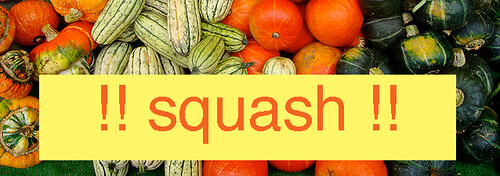 |
| From getinthegarden.com |
Seed saving. This is something I've never actually done outside of trying to sprout an avocado pitt in a cup of water balancing on some toothpicks. I'm not even sure of the ins and outs, other than that you gut your vegetable and clean your seeds, dry them from the moisture, and put them away (labeled) in a paper envelope or something and out of the sunlight.
But, to me it doesn't seem that easy.
First, there's cross pollination to worry about. Sure, they squashes may not have cross pollinated with other vegetable families (no eggplant-butternut cyborg hybrids around here!), but they can cross-pollinate with each other. Which means that you can get an mixed squash rather than a "pure breed".
This is what the Seed and Plant Sanctuary for Canada (on Saltspring) have to say about cross polination:
Squash and Pumpkins
Squash and pumpkins are also pollinated by bees. The four different species of squash and pumpkins won't cross species or cross with cucumbers and melons. Cucurbita pepo includes all common summer squashes, all acorn types, the orange pumpkin types, Delicata, Lady Godiva and Spaghetti. Cucurbita maxima includes Buttercup, Hubbard, Delicious, Banana and Hokkaido. Cucurbita moschata includes Butternut and Cheese types. Cucurbita mixta includes the Cushaw squashes. All will cross with their own species members.
Fastening paper bags over the female flowers, then dabbing pollen from male flowers onto the female, and closing the bag again until the chance of cross-pollination is over, ensures genetic integrity. For starters, grow a representative of one or more species each growing season.
The other thing I'm concerned about is using seeds from vegetables at the store. Food at the grocery store wasn't really grown here. Sure the seed from a squash in Mexico may be grown here, but how much of that seed has been altered by GMOs? And, if that seed ever cross pollinated with a Monsanto seed, will I one day become liable for payback to Monsanto because of a reckless butternut seed? (Food Inc., the movie, is a good accessible source for this argument, though obviously "biased". There's also a tonne of books on the same or similar subjects. Getting locally (10mile is probably best) grown squash, preferably organic, is the best way to go. It means that the immunities and environmental uniqueness of your region and the air/pollen you breathe will be in your squash.
I'm also concerned about if I'm using the right type of seeds. The general rule is to not use hybrid seeds, but if I'm using seeds from the hubbard from my neighbourhood farm, how do I know if they've used a hybrid seed or not? Hybrid seeds are best explained by this site:
F1 hybrids are the first generation seeds/plants resulting from a cross mating of distinctly different parental types, the offspring of which produce a new, uniform seed variety with specific characteristics from both parents. Crossing specific parent plants produces a hybrid seed (plant) by means of controlled pollination. To produce consistent F1 hybrids, the original cross must be repeated each season. As in the original cross, this is done through controlled hand-pollination, and explains why F1-seeds are so expensive.
Heirloom seeds are considered "better" for seed saving because then you get a product that is true to type (ie. a butternut that grows as a butternut, not a hubbard. But, using hybrid seeds isn't the end of the world because you'll get surprise produce, which is always fun! I mean, I'm not getting into gardening for regularity, as I can just by that from the store.
I've started harvesting some of my squash seed, and need to get better at it. Now that I know they'll probably all sprout I could have an interesting squash and pumpkin garden!
Here are some pretty solid directions on how to harvest your seed from the Seed and Plant Sanctuary for Canada (on Saltspring):
Summer squash must be left on the vine about eight weeks past its normal harvesting date until the skin becomes as hard as that of winter squash. All squash and pumpkin seed will gain vigor if allowed to ripen longer in the fruit. Removing and storing them can wait for a month or two. They may be left past the first fall frost.
Cut the fruit of the mature pumpkin or squash in half. Remove the seeds and moist material around them with a large spoon, place it all in a large bowl, add some water and work the mixture through the fingers. The seeds will separate gradually. Wash them again and spread them out on wax paper or screens to dry for a week or more, moving them about daily so they don't remain in small wet piles. Cull out any flat seeds: only the plump ones are viable.
If kept in a sealed jar, check them after a few weeks to see if there is any sign of moisture. If so, take them out for additional drying.
And lastly, a few youtube videos (because how can we do anything without guidance of one of these! ha!). Oh and sorry if you have to watch Mormon.org ads !! they're so weird.



No comments:
Post a Comment